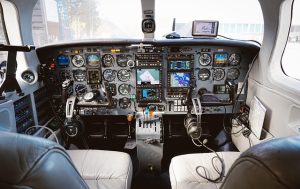
When researching aircraft systems, you may come across pitot-static systems. Pilots today rely on a variety of instruments to provide essential flight data. The pitot-static system is a collection of instruments that’s responsible for measuring airspeed, vertical speed, altitude and more.
Overview of Pitot-Static Systems
Nearly all modern airplanes have a pitot-static system. Pitot-static systems feature two types of pressure-reading sensors: a pitot tube and a static port. Using these sensors, they are able to measure flight-related metrics. Nearly all modern airplanes have a pitot-static system.
Pitot Tube vs Static Port
The pitot tube is designed to measure dynamic or “pitot” pressure, whereas the static port is designed to measure static pressure. All pitot-static systems have at least one pitot tube and static port.
Most airplanes have a pitot tube on the nose or leading edge of the wing. It consists of a small probe-like sensor that’s usually heated to prevent it from freezing up at high altitudes. Static ports, on the other hand, are small openings on the fuselage.
How Pitot-Static Systems Work
Pitot-static systems work by measuring pitot pressure and static pressure. Using this information, corresponding instruments can display airspeed, vertical speed, altitude and more.
The pitot tube works by collecting air as the airplane moves forward. The faster the airplane is traveling, the higher the pitot pressure will be. Static ports, in comparison, work by measuring the atmospheric pressure around the airplane. By identifying both types of pressure — pitot pressure and static pressure — the system can calculate the aforementioned flight metrics.
Why Airplanes Need a Pitot-Static System
Airplanes need a pitot-static system because it provides essential pressure-related data. Most airplanes have a Global Positioning System (GPS). While GPS can measure groundspeed, however, it can’t measure airspeed, altitude or vertical speed. That’s where pitot-static systems come into play.
Consisting of one or more pitot tubes and static ports, pitot-static systems can measure airspeed, altitude or vertical speed. Pilots use this data to adjust flight parameters, ensuring a safe and efficient flight.
In Conclusion
The pitot-static system remains one of the most critical components in modern aviation. By combining the readings from the pitot tube and static port, it gives pilots accurate information about airspeed, altitude and vertical speed, which GPS alone cannot provide. Without these measurements, safe flight would not be possible.


